Systems Thinking and Sustainability: Australia's Ageing Workforce
VerifiedAdded on 2023/06/07
|11
|2945
|218
Essay
AI Summary
This essay examines the critical role of systems thinking in developing solutions to sustainability challenges, focusing on the context of Australia's ageing workforce. The introduction defines sustainability and highlights the challenges, emphasizing the effectiveness of systems thinking in problem-solving. The discussion section delves into the core concepts of systems thinking, its evolution from computational thinking, and its application in addressing the complexities of an ageing workforce. It explores various conceptions of systems thinking, frameworks for mental growth, and the system thinking process, illustrated by the example of the Australian workforce. The essay further analyzes modern conceptions of sustainability, the importance of business models, and theoretical considerations, including the triple bottom line model and strategic sustainable development frameworks. The conclusion reinforces the significance of systems thinking in achieving sustainable development by addressing the challenges faced by Australia's aging workforce and provides a comprehensive understanding of the subject matter.
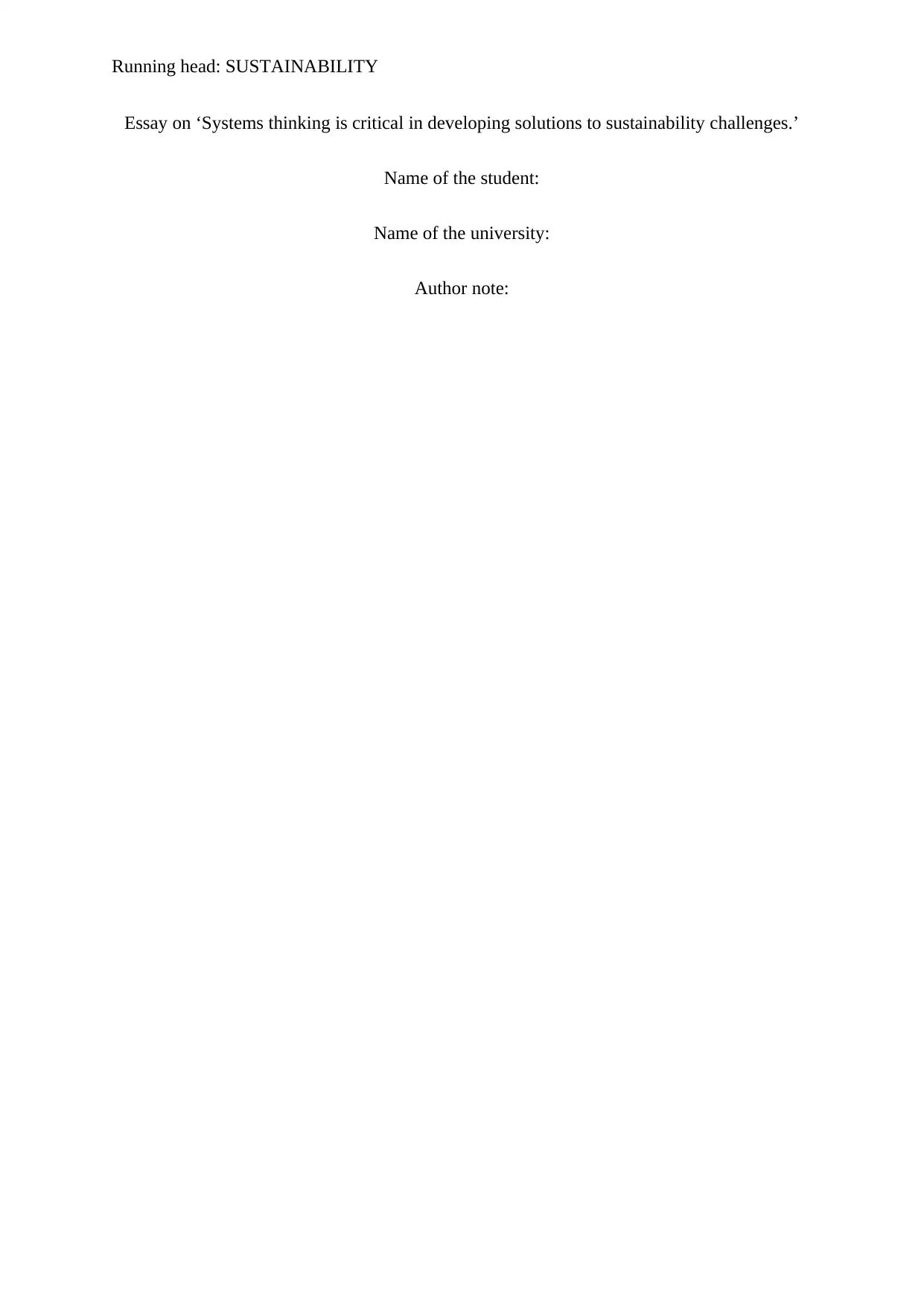
Running head: SUSTAINABILITY
Essay on ‘Systems thinking is critical in developing solutions to sustainability challenges.’
Name of the student:
Name of the university:
Author note:
Essay on ‘Systems thinking is critical in developing solutions to sustainability challenges.’
Name of the student:
Name of the university:
Author note:
Paraphrase This Document
Need a fresh take? Get an instant paraphrase of this document with our AI Paraphraser
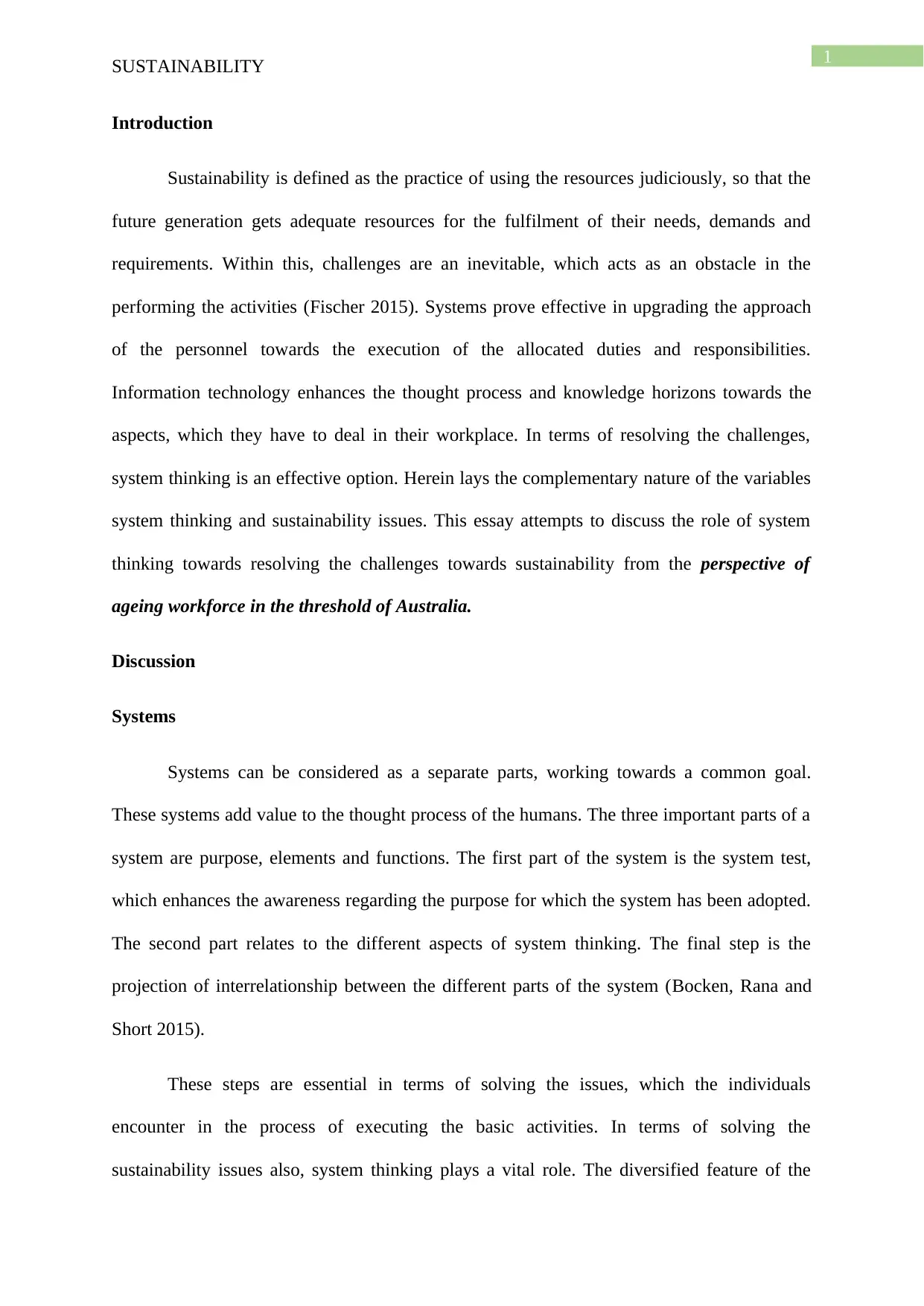
1
SUSTAINABILITY
Introduction
Sustainability is defined as the practice of using the resources judiciously, so that the
future generation gets adequate resources for the fulfilment of their needs, demands and
requirements. Within this, challenges are an inevitable, which acts as an obstacle in the
performing the activities (Fischer 2015). Systems prove effective in upgrading the approach
of the personnel towards the execution of the allocated duties and responsibilities.
Information technology enhances the thought process and knowledge horizons towards the
aspects, which they have to deal in their workplace. In terms of resolving the challenges,
system thinking is an effective option. Herein lays the complementary nature of the variables
system thinking and sustainability issues. This essay attempts to discuss the role of system
thinking towards resolving the challenges towards sustainability from the perspective of
ageing workforce in the threshold of Australia.
Discussion
Systems
Systems can be considered as a separate parts, working towards a common goal.
These systems add value to the thought process of the humans. The three important parts of a
system are purpose, elements and functions. The first part of the system is the system test,
which enhances the awareness regarding the purpose for which the system has been adopted.
The second part relates to the different aspects of system thinking. The final step is the
projection of interrelationship between the different parts of the system (Bocken, Rana and
Short 2015).
These steps are essential in terms of solving the issues, which the individuals
encounter in the process of executing the basic activities. In terms of solving the
sustainability issues also, system thinking plays a vital role. The diversified feature of the
SUSTAINABILITY
Introduction
Sustainability is defined as the practice of using the resources judiciously, so that the
future generation gets adequate resources for the fulfilment of their needs, demands and
requirements. Within this, challenges are an inevitable, which acts as an obstacle in the
performing the activities (Fischer 2015). Systems prove effective in upgrading the approach
of the personnel towards the execution of the allocated duties and responsibilities.
Information technology enhances the thought process and knowledge horizons towards the
aspects, which they have to deal in their workplace. In terms of resolving the challenges,
system thinking is an effective option. Herein lays the complementary nature of the variables
system thinking and sustainability issues. This essay attempts to discuss the role of system
thinking towards resolving the challenges towards sustainability from the perspective of
ageing workforce in the threshold of Australia.
Discussion
Systems
Systems can be considered as a separate parts, working towards a common goal.
These systems add value to the thought process of the humans. The three important parts of a
system are purpose, elements and functions. The first part of the system is the system test,
which enhances the awareness regarding the purpose for which the system has been adopted.
The second part relates to the different aspects of system thinking. The final step is the
projection of interrelationship between the different parts of the system (Bocken, Rana and
Short 2015).
These steps are essential in terms of solving the issues, which the individuals
encounter in the process of executing the basic activities. In terms of solving the
sustainability issues also, system thinking plays a vital role. The diversified feature of the
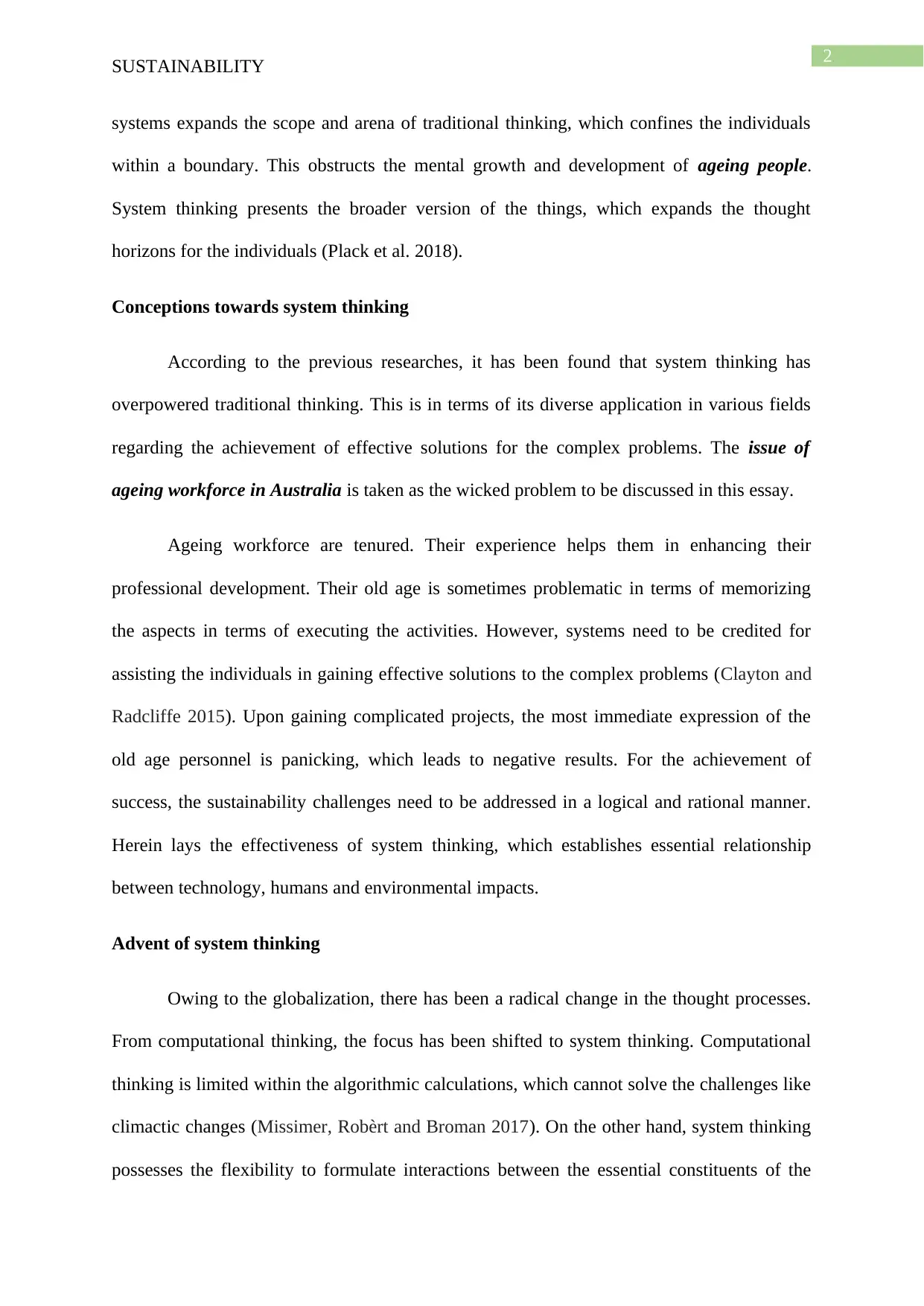
2
SUSTAINABILITY
systems expands the scope and arena of traditional thinking, which confines the individuals
within a boundary. This obstructs the mental growth and development of ageing people.
System thinking presents the broader version of the things, which expands the thought
horizons for the individuals (Plack et al. 2018).
Conceptions towards system thinking
According to the previous researches, it has been found that system thinking has
overpowered traditional thinking. This is in terms of its diverse application in various fields
regarding the achievement of effective solutions for the complex problems. The issue of
ageing workforce in Australia is taken as the wicked problem to be discussed in this essay.
Ageing workforce are tenured. Their experience helps them in enhancing their
professional development. Their old age is sometimes problematic in terms of memorizing
the aspects in terms of executing the activities. However, systems need to be credited for
assisting the individuals in gaining effective solutions to the complex problems (Clayton and
Radcliffe 2015). Upon gaining complicated projects, the most immediate expression of the
old age personnel is panicking, which leads to negative results. For the achievement of
success, the sustainability challenges need to be addressed in a logical and rational manner.
Herein lays the effectiveness of system thinking, which establishes essential relationship
between technology, humans and environmental impacts.
Advent of system thinking
Owing to the globalization, there has been a radical change in the thought processes.
From computational thinking, the focus has been shifted to system thinking. Computational
thinking is limited within the algorithmic calculations, which cannot solve the challenges like
climactic changes (Missimer, Robèrt and Broman 2017). On the other hand, system thinking
possesses the flexibility to formulate interactions between the essential constituents of the
SUSTAINABILITY
systems expands the scope and arena of traditional thinking, which confines the individuals
within a boundary. This obstructs the mental growth and development of ageing people.
System thinking presents the broader version of the things, which expands the thought
horizons for the individuals (Plack et al. 2018).
Conceptions towards system thinking
According to the previous researches, it has been found that system thinking has
overpowered traditional thinking. This is in terms of its diverse application in various fields
regarding the achievement of effective solutions for the complex problems. The issue of
ageing workforce in Australia is taken as the wicked problem to be discussed in this essay.
Ageing workforce are tenured. Their experience helps them in enhancing their
professional development. Their old age is sometimes problematic in terms of memorizing
the aspects in terms of executing the activities. However, systems need to be credited for
assisting the individuals in gaining effective solutions to the complex problems (Clayton and
Radcliffe 2015). Upon gaining complicated projects, the most immediate expression of the
old age personnel is panicking, which leads to negative results. For the achievement of
success, the sustainability challenges need to be addressed in a logical and rational manner.
Herein lays the effectiveness of system thinking, which establishes essential relationship
between technology, humans and environmental impacts.
Advent of system thinking
Owing to the globalization, there has been a radical change in the thought processes.
From computational thinking, the focus has been shifted to system thinking. Computational
thinking is limited within the algorithmic calculations, which cannot solve the challenges like
climactic changes (Missimer, Robèrt and Broman 2017). On the other hand, system thinking
possesses the flexibility to formulate interactions between the essential constituents of the
You're viewing a preview
Unlock full access by subscribing today!
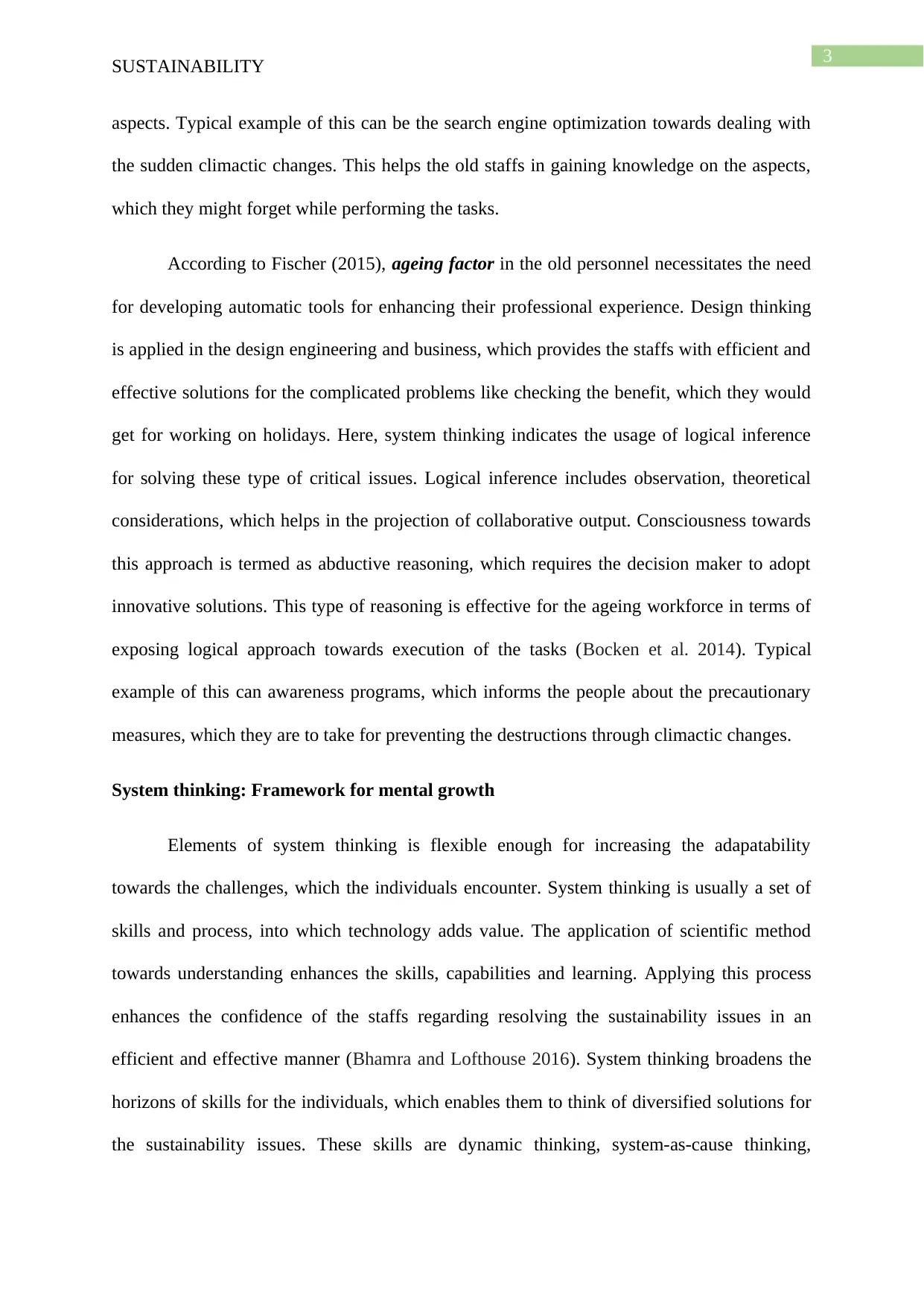
3
SUSTAINABILITY
aspects. Typical example of this can be the search engine optimization towards dealing with
the sudden climactic changes. This helps the old staffs in gaining knowledge on the aspects,
which they might forget while performing the tasks.
According to Fischer (2015), ageing factor in the old personnel necessitates the need
for developing automatic tools for enhancing their professional experience. Design thinking
is applied in the design engineering and business, which provides the staffs with efficient and
effective solutions for the complicated problems like checking the benefit, which they would
get for working on holidays. Here, system thinking indicates the usage of logical inference
for solving these type of critical issues. Logical inference includes observation, theoretical
considerations, which helps in the projection of collaborative output. Consciousness towards
this approach is termed as abductive reasoning, which requires the decision maker to adopt
innovative solutions. This type of reasoning is effective for the ageing workforce in terms of
exposing logical approach towards execution of the tasks (Bocken et al. 2014). Typical
example of this can awareness programs, which informs the people about the precautionary
measures, which they are to take for preventing the destructions through climactic changes.
System thinking: Framework for mental growth
Elements of system thinking is flexible enough for increasing the adapatability
towards the challenges, which the individuals encounter. System thinking is usually a set of
skills and process, into which technology adds value. The application of scientific method
towards understanding enhances the skills, capabilities and learning. Applying this process
enhances the confidence of the staffs regarding resolving the sustainability issues in an
efficient and effective manner (Bhamra and Lofthouse 2016). System thinking broadens the
horizons of skills for the individuals, which enables them to think of diversified solutions for
the sustainability issues. These skills are dynamic thinking, system-as-cause thinking,
SUSTAINABILITY
aspects. Typical example of this can be the search engine optimization towards dealing with
the sudden climactic changes. This helps the old staffs in gaining knowledge on the aspects,
which they might forget while performing the tasks.
According to Fischer (2015), ageing factor in the old personnel necessitates the need
for developing automatic tools for enhancing their professional experience. Design thinking
is applied in the design engineering and business, which provides the staffs with efficient and
effective solutions for the complicated problems like checking the benefit, which they would
get for working on holidays. Here, system thinking indicates the usage of logical inference
for solving these type of critical issues. Logical inference includes observation, theoretical
considerations, which helps in the projection of collaborative output. Consciousness towards
this approach is termed as abductive reasoning, which requires the decision maker to adopt
innovative solutions. This type of reasoning is effective for the ageing workforce in terms of
exposing logical approach towards execution of the tasks (Bocken et al. 2014). Typical
example of this can awareness programs, which informs the people about the precautionary
measures, which they are to take for preventing the destructions through climactic changes.
System thinking: Framework for mental growth
Elements of system thinking is flexible enough for increasing the adapatability
towards the challenges, which the individuals encounter. System thinking is usually a set of
skills and process, into which technology adds value. The application of scientific method
towards understanding enhances the skills, capabilities and learning. Applying this process
enhances the confidence of the staffs regarding resolving the sustainability issues in an
efficient and effective manner (Bhamra and Lofthouse 2016). System thinking broadens the
horizons of skills for the individuals, which enables them to think of diversified solutions for
the sustainability issues. These skills are dynamic thinking, system-as-cause thinking,
Paraphrase This Document
Need a fresh take? Get an instant paraphrase of this document with our AI Paraphraser
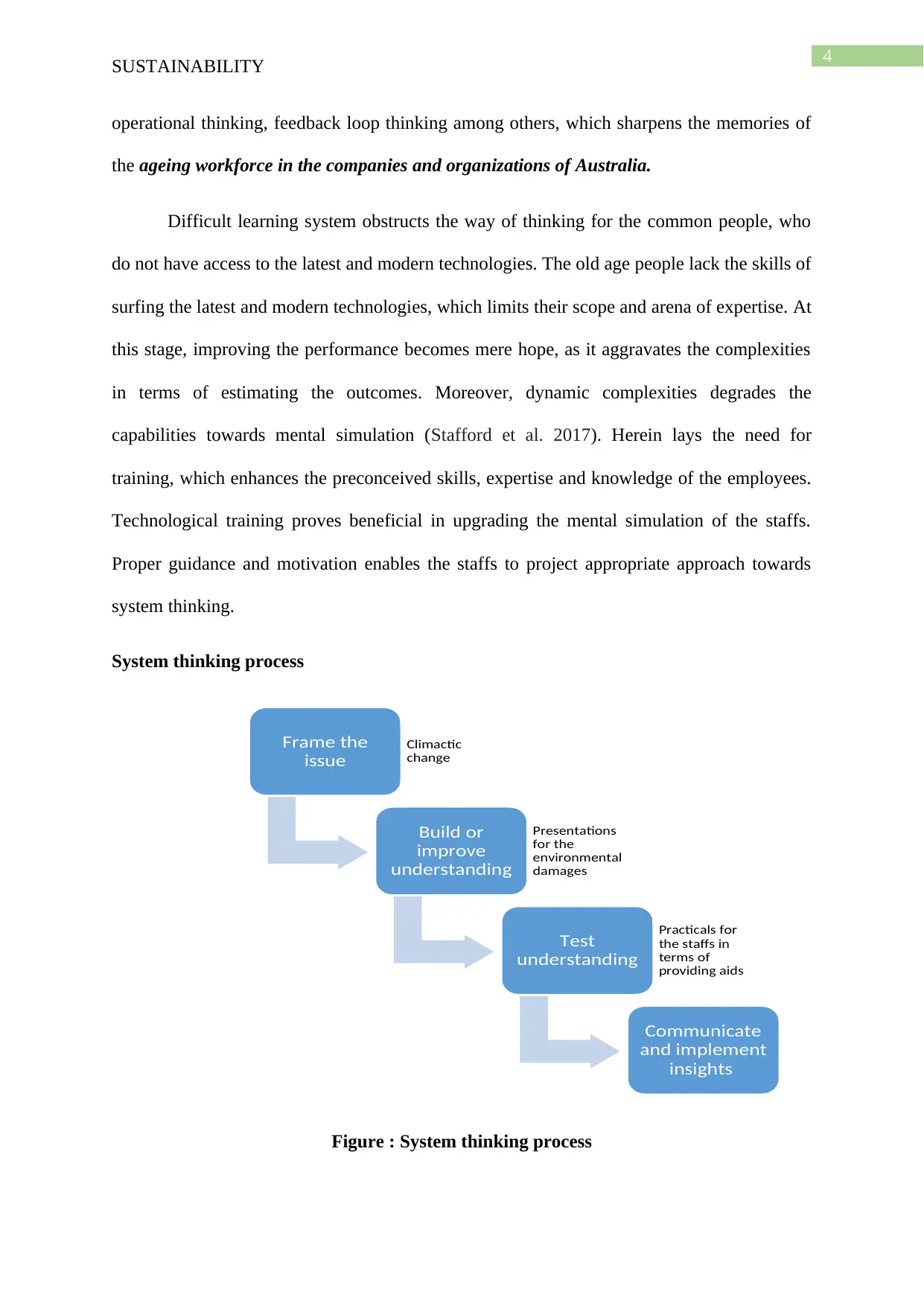
4
SUSTAINABILITY
operational thinking, feedback loop thinking among others, which sharpens the memories of
the ageing workforce in the companies and organizations of Australia.
Difficult learning system obstructs the way of thinking for the common people, who
do not have access to the latest and modern technologies. The old age people lack the skills of
surfing the latest and modern technologies, which limits their scope and arena of expertise. At
this stage, improving the performance becomes mere hope, as it aggravates the complexities
in terms of estimating the outcomes. Moreover, dynamic complexities degrades the
capabilities towards mental simulation (Stafford et al. 2017). Herein lays the need for
training, which enhances the preconceived skills, expertise and knowledge of the employees.
Technological training proves beneficial in upgrading the mental simulation of the staffs.
Proper guidance and motivation enables the staffs to project appropriate approach towards
system thinking.
System thinking process
Figure : System thinking process
Frame the
issue
Climactic
change
Build or
improve
understanding
Presentations
for the
environmental
damages
Test
understanding
Practicals for
the staffs in
terms of
providing aids
Communicate
and implement
insights
SUSTAINABILITY
operational thinking, feedback loop thinking among others, which sharpens the memories of
the ageing workforce in the companies and organizations of Australia.
Difficult learning system obstructs the way of thinking for the common people, who
do not have access to the latest and modern technologies. The old age people lack the skills of
surfing the latest and modern technologies, which limits their scope and arena of expertise. At
this stage, improving the performance becomes mere hope, as it aggravates the complexities
in terms of estimating the outcomes. Moreover, dynamic complexities degrades the
capabilities towards mental simulation (Stafford et al. 2017). Herein lays the need for
training, which enhances the preconceived skills, expertise and knowledge of the employees.
Technological training proves beneficial in upgrading the mental simulation of the staffs.
Proper guidance and motivation enables the staffs to project appropriate approach towards
system thinking.
System thinking process
Figure : System thinking process
Frame the
issue
Climactic
change
Build or
improve
understanding
Presentations
for the
environmental
damages
Test
understanding
Practicals for
the staffs in
terms of
providing aids
Communicate
and implement
insights
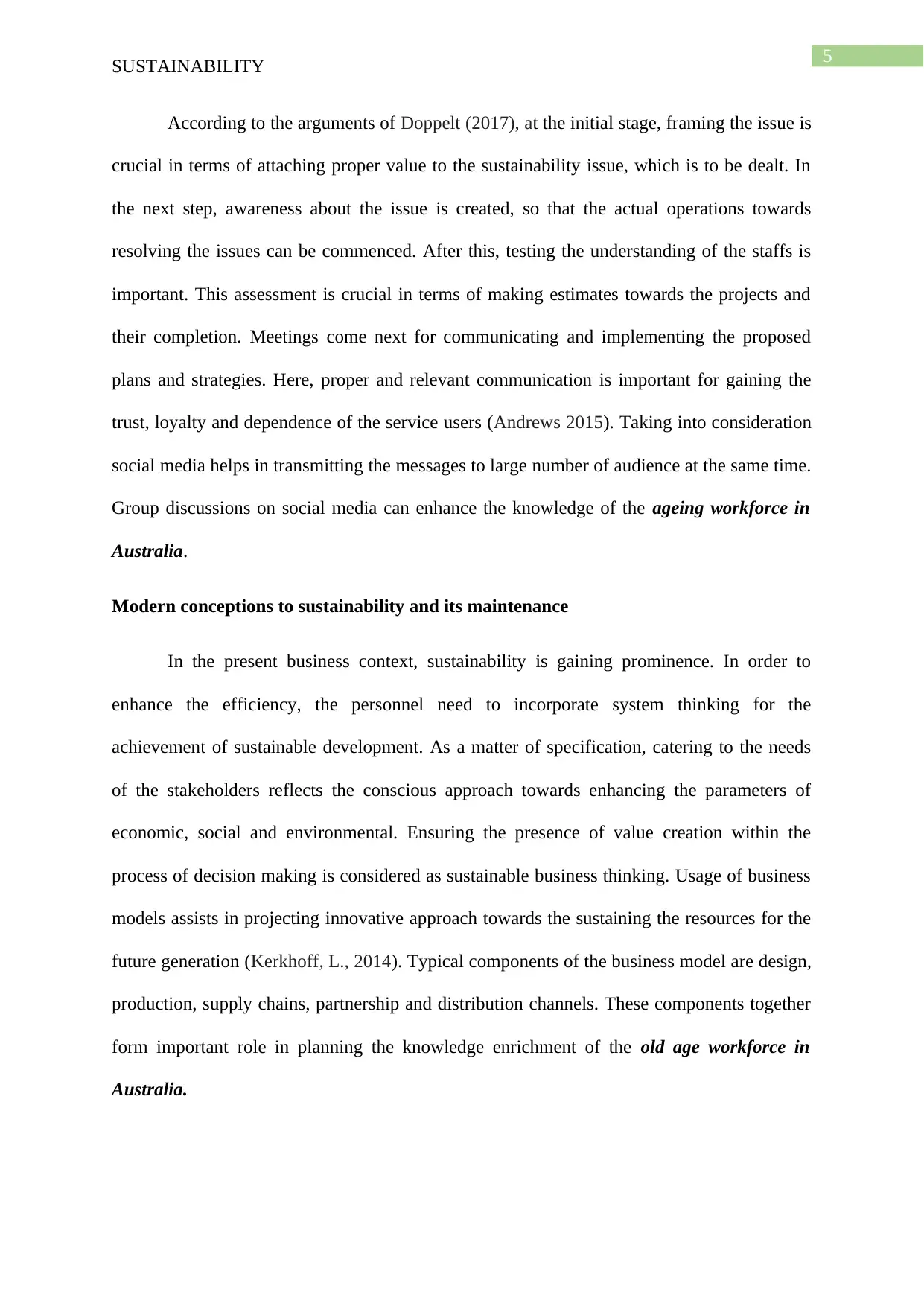
5
SUSTAINABILITY
According to the arguments of Doppelt (2017), at the initial stage, framing the issue is
crucial in terms of attaching proper value to the sustainability issue, which is to be dealt. In
the next step, awareness about the issue is created, so that the actual operations towards
resolving the issues can be commenced. After this, testing the understanding of the staffs is
important. This assessment is crucial in terms of making estimates towards the projects and
their completion. Meetings come next for communicating and implementing the proposed
plans and strategies. Here, proper and relevant communication is important for gaining the
trust, loyalty and dependence of the service users (Andrews 2015). Taking into consideration
social media helps in transmitting the messages to large number of audience at the same time.
Group discussions on social media can enhance the knowledge of the ageing workforce in
Australia.
Modern conceptions to sustainability and its maintenance
In the present business context, sustainability is gaining prominence. In order to
enhance the efficiency, the personnel need to incorporate system thinking for the
achievement of sustainable development. As a matter of specification, catering to the needs
of the stakeholders reflects the conscious approach towards enhancing the parameters of
economic, social and environmental. Ensuring the presence of value creation within the
process of decision making is considered as sustainable business thinking. Usage of business
models assists in projecting innovative approach towards the sustaining the resources for the
future generation (Kerkhoff, L., 2014). Typical components of the business model are design,
production, supply chains, partnership and distribution channels. These components together
form important role in planning the knowledge enrichment of the old age workforce in
Australia.
SUSTAINABILITY
According to the arguments of Doppelt (2017), at the initial stage, framing the issue is
crucial in terms of attaching proper value to the sustainability issue, which is to be dealt. In
the next step, awareness about the issue is created, so that the actual operations towards
resolving the issues can be commenced. After this, testing the understanding of the staffs is
important. This assessment is crucial in terms of making estimates towards the projects and
their completion. Meetings come next for communicating and implementing the proposed
plans and strategies. Here, proper and relevant communication is important for gaining the
trust, loyalty and dependence of the service users (Andrews 2015). Taking into consideration
social media helps in transmitting the messages to large number of audience at the same time.
Group discussions on social media can enhance the knowledge of the ageing workforce in
Australia.
Modern conceptions to sustainability and its maintenance
In the present business context, sustainability is gaining prominence. In order to
enhance the efficiency, the personnel need to incorporate system thinking for the
achievement of sustainable development. As a matter of specification, catering to the needs
of the stakeholders reflects the conscious approach towards enhancing the parameters of
economic, social and environmental. Ensuring the presence of value creation within the
process of decision making is considered as sustainable business thinking. Usage of business
models assists in projecting innovative approach towards the sustaining the resources for the
future generation (Kerkhoff, L., 2014). Typical components of the business model are design,
production, supply chains, partnership and distribution channels. These components together
form important role in planning the knowledge enrichment of the old age workforce in
Australia.
You're viewing a preview
Unlock full access by subscribing today!
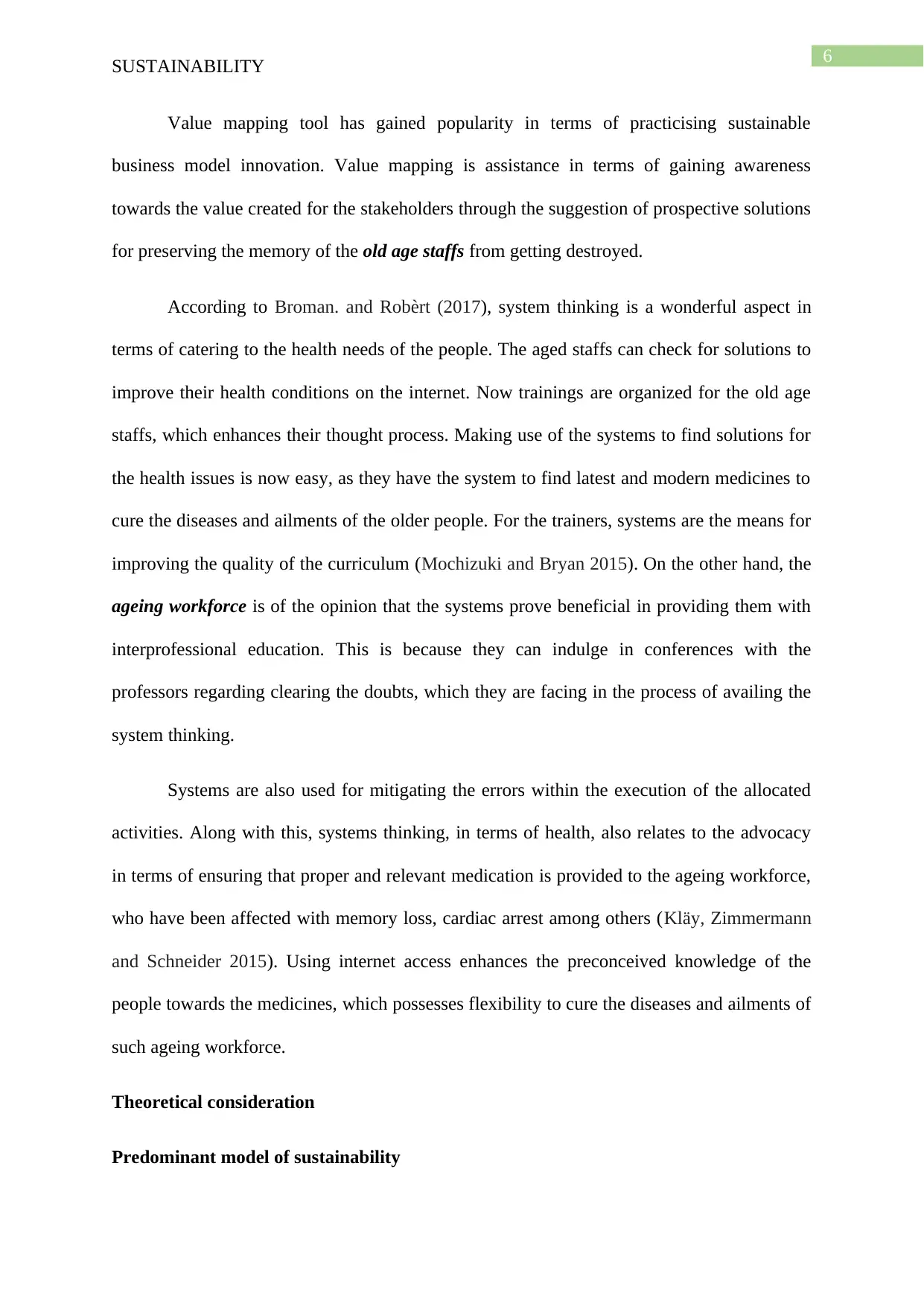
6
SUSTAINABILITY
Value mapping tool has gained popularity in terms of practicising sustainable
business model innovation. Value mapping is assistance in terms of gaining awareness
towards the value created for the stakeholders through the suggestion of prospective solutions
for preserving the memory of the old age staffs from getting destroyed.
According to Broman. and Robèrt (2017), system thinking is a wonderful aspect in
terms of catering to the health needs of the people. The aged staffs can check for solutions to
improve their health conditions on the internet. Now trainings are organized for the old age
staffs, which enhances their thought process. Making use of the systems to find solutions for
the health issues is now easy, as they have the system to find latest and modern medicines to
cure the diseases and ailments of the older people. For the trainers, systems are the means for
improving the quality of the curriculum (Mochizuki and Bryan 2015). On the other hand, the
ageing workforce is of the opinion that the systems prove beneficial in providing them with
interprofessional education. This is because they can indulge in conferences with the
professors regarding clearing the doubts, which they are facing in the process of availing the
system thinking.
Systems are also used for mitigating the errors within the execution of the allocated
activities. Along with this, systems thinking, in terms of health, also relates to the advocacy
in terms of ensuring that proper and relevant medication is provided to the ageing workforce,
who have been affected with memory loss, cardiac arrest among others (Kläy, Zimmermann
and Schneider 2015). Using internet access enhances the preconceived knowledge of the
people towards the medicines, which possesses flexibility to cure the diseases and ailments of
such ageing workforce.
Theoretical consideration
Predominant model of sustainability
SUSTAINABILITY
Value mapping tool has gained popularity in terms of practicising sustainable
business model innovation. Value mapping is assistance in terms of gaining awareness
towards the value created for the stakeholders through the suggestion of prospective solutions
for preserving the memory of the old age staffs from getting destroyed.
According to Broman. and Robèrt (2017), system thinking is a wonderful aspect in
terms of catering to the health needs of the people. The aged staffs can check for solutions to
improve their health conditions on the internet. Now trainings are organized for the old age
staffs, which enhances their thought process. Making use of the systems to find solutions for
the health issues is now easy, as they have the system to find latest and modern medicines to
cure the diseases and ailments of the older people. For the trainers, systems are the means for
improving the quality of the curriculum (Mochizuki and Bryan 2015). On the other hand, the
ageing workforce is of the opinion that the systems prove beneficial in providing them with
interprofessional education. This is because they can indulge in conferences with the
professors regarding clearing the doubts, which they are facing in the process of availing the
system thinking.
Systems are also used for mitigating the errors within the execution of the allocated
activities. Along with this, systems thinking, in terms of health, also relates to the advocacy
in terms of ensuring that proper and relevant medication is provided to the ageing workforce,
who have been affected with memory loss, cardiac arrest among others (Kläy, Zimmermann
and Schneider 2015). Using internet access enhances the preconceived knowledge of the
people towards the medicines, which possesses flexibility to cure the diseases and ailments of
such ageing workforce.
Theoretical consideration
Predominant model of sustainability
Paraphrase This Document
Need a fresh take? Get an instant paraphrase of this document with our AI Paraphraser
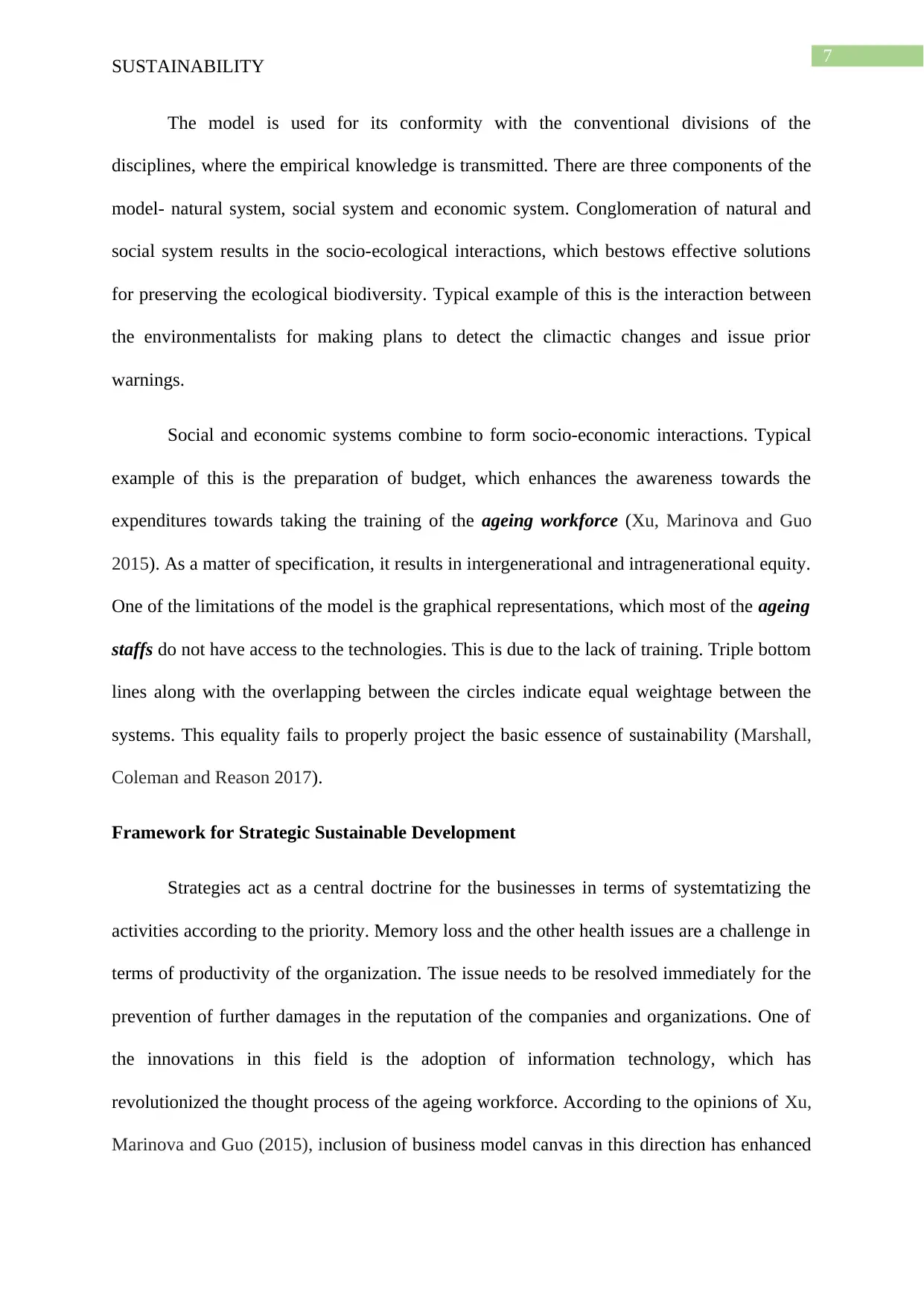
7
SUSTAINABILITY
The model is used for its conformity with the conventional divisions of the
disciplines, where the empirical knowledge is transmitted. There are three components of the
model- natural system, social system and economic system. Conglomeration of natural and
social system results in the socio-ecological interactions, which bestows effective solutions
for preserving the ecological biodiversity. Typical example of this is the interaction between
the environmentalists for making plans to detect the climactic changes and issue prior
warnings.
Social and economic systems combine to form socio-economic interactions. Typical
example of this is the preparation of budget, which enhances the awareness towards the
expenditures towards taking the training of the ageing workforce (Xu, Marinova and Guo
2015). As a matter of specification, it results in intergenerational and intragenerational equity.
One of the limitations of the model is the graphical representations, which most of the ageing
staffs do not have access to the technologies. This is due to the lack of training. Triple bottom
lines along with the overlapping between the circles indicate equal weightage between the
systems. This equality fails to properly project the basic essence of sustainability (Marshall,
Coleman and Reason 2017).
Framework for Strategic Sustainable Development
Strategies act as a central doctrine for the businesses in terms of systemtatizing the
activities according to the priority. Memory loss and the other health issues are a challenge in
terms of productivity of the organization. The issue needs to be resolved immediately for the
prevention of further damages in the reputation of the companies and organizations. One of
the innovations in this field is the adoption of information technology, which has
revolutionized the thought process of the ageing workforce. According to the opinions of Xu,
Marinova and Guo (2015), inclusion of business model canvas in this direction has enhanced
SUSTAINABILITY
The model is used for its conformity with the conventional divisions of the
disciplines, where the empirical knowledge is transmitted. There are three components of the
model- natural system, social system and economic system. Conglomeration of natural and
social system results in the socio-ecological interactions, which bestows effective solutions
for preserving the ecological biodiversity. Typical example of this is the interaction between
the environmentalists for making plans to detect the climactic changes and issue prior
warnings.
Social and economic systems combine to form socio-economic interactions. Typical
example of this is the preparation of budget, which enhances the awareness towards the
expenditures towards taking the training of the ageing workforce (Xu, Marinova and Guo
2015). As a matter of specification, it results in intergenerational and intragenerational equity.
One of the limitations of the model is the graphical representations, which most of the ageing
staffs do not have access to the technologies. This is due to the lack of training. Triple bottom
lines along with the overlapping between the circles indicate equal weightage between the
systems. This equality fails to properly project the basic essence of sustainability (Marshall,
Coleman and Reason 2017).
Framework for Strategic Sustainable Development
Strategies act as a central doctrine for the businesses in terms of systemtatizing the
activities according to the priority. Memory loss and the other health issues are a challenge in
terms of productivity of the organization. The issue needs to be resolved immediately for the
prevention of further damages in the reputation of the companies and organizations. One of
the innovations in this field is the adoption of information technology, which has
revolutionized the thought process of the ageing workforce. According to the opinions of Xu,
Marinova and Guo (2015), inclusion of business model canvas in this direction has enhanced
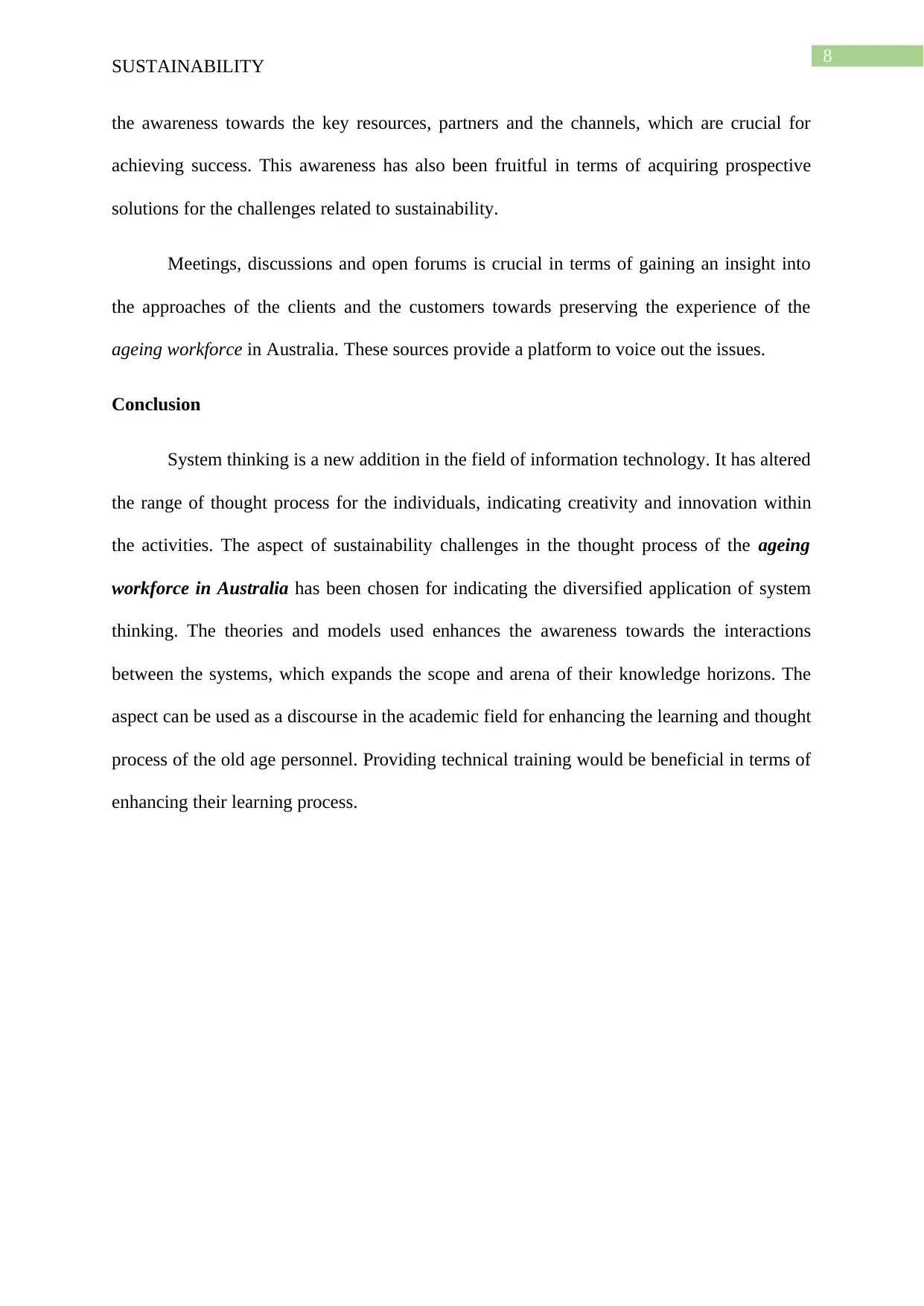
8
SUSTAINABILITY
the awareness towards the key resources, partners and the channels, which are crucial for
achieving success. This awareness has also been fruitful in terms of acquiring prospective
solutions for the challenges related to sustainability.
Meetings, discussions and open forums is crucial in terms of gaining an insight into
the approaches of the clients and the customers towards preserving the experience of the
ageing workforce in Australia. These sources provide a platform to voice out the issues.
Conclusion
System thinking is a new addition in the field of information technology. It has altered
the range of thought process for the individuals, indicating creativity and innovation within
the activities. The aspect of sustainability challenges in the thought process of the ageing
workforce in Australia has been chosen for indicating the diversified application of system
thinking. The theories and models used enhances the awareness towards the interactions
between the systems, which expands the scope and arena of their knowledge horizons. The
aspect can be used as a discourse in the academic field for enhancing the learning and thought
process of the old age personnel. Providing technical training would be beneficial in terms of
enhancing their learning process.
SUSTAINABILITY
the awareness towards the key resources, partners and the channels, which are crucial for
achieving success. This awareness has also been fruitful in terms of acquiring prospective
solutions for the challenges related to sustainability.
Meetings, discussions and open forums is crucial in terms of gaining an insight into
the approaches of the clients and the customers towards preserving the experience of the
ageing workforce in Australia. These sources provide a platform to voice out the issues.
Conclusion
System thinking is a new addition in the field of information technology. It has altered
the range of thought process for the individuals, indicating creativity and innovation within
the activities. The aspect of sustainability challenges in the thought process of the ageing
workforce in Australia has been chosen for indicating the diversified application of system
thinking. The theories and models used enhances the awareness towards the interactions
between the systems, which expands the scope and arena of their knowledge horizons. The
aspect can be used as a discourse in the academic field for enhancing the learning and thought
process of the old age personnel. Providing technical training would be beneficial in terms of
enhancing their learning process.
You're viewing a preview
Unlock full access by subscribing today!
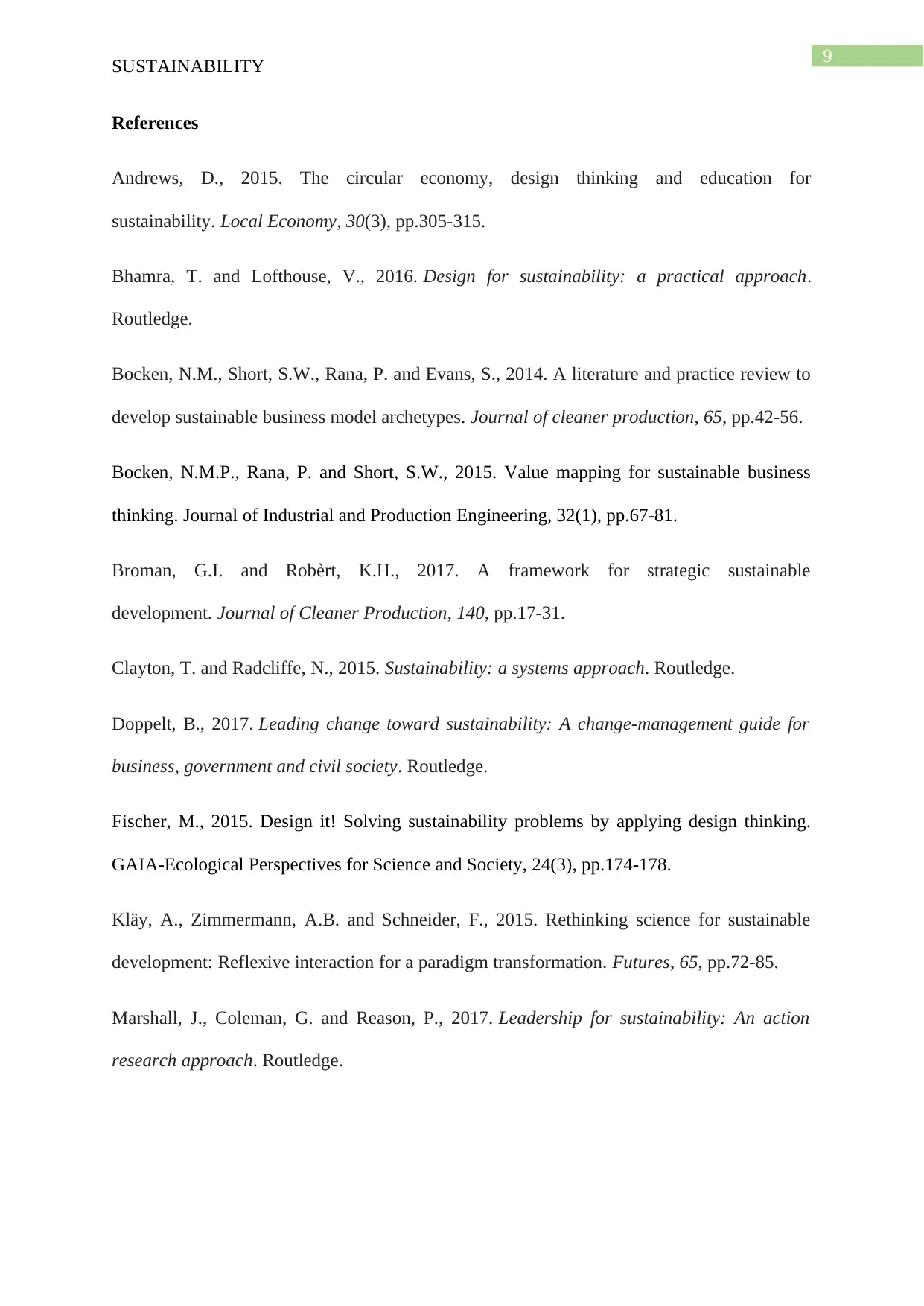
9
SUSTAINABILITY
References
Andrews, D., 2015. The circular economy, design thinking and education for
sustainability. Local Economy, 30(3), pp.305-315.
Bhamra, T. and Lofthouse, V., 2016. Design for sustainability: a practical approach.
Routledge.
Bocken, N.M., Short, S.W., Rana, P. and Evans, S., 2014. A literature and practice review to
develop sustainable business model archetypes. Journal of cleaner production, 65, pp.42-56.
Bocken, N.M.P., Rana, P. and Short, S.W., 2015. Value mapping for sustainable business
thinking. Journal of Industrial and Production Engineering, 32(1), pp.67-81.
Broman, G.I. and Robèrt, K.H., 2017. A framework for strategic sustainable
development. Journal of Cleaner Production, 140, pp.17-31.
Clayton, T. and Radcliffe, N., 2015. Sustainability: a systems approach. Routledge.
Doppelt, B., 2017. Leading change toward sustainability: A change-management guide for
business, government and civil society. Routledge.
Fischer, M., 2015. Design it! Solving sustainability problems by applying design thinking.
GAIA-Ecological Perspectives for Science and Society, 24(3), pp.174-178.
Kläy, A., Zimmermann, A.B. and Schneider, F., 2015. Rethinking science for sustainable
development: Reflexive interaction for a paradigm transformation. Futures, 65, pp.72-85.
Marshall, J., Coleman, G. and Reason, P., 2017. Leadership for sustainability: An action
research approach. Routledge.
SUSTAINABILITY
References
Andrews, D., 2015. The circular economy, design thinking and education for
sustainability. Local Economy, 30(3), pp.305-315.
Bhamra, T. and Lofthouse, V., 2016. Design for sustainability: a practical approach.
Routledge.
Bocken, N.M., Short, S.W., Rana, P. and Evans, S., 2014. A literature and practice review to
develop sustainable business model archetypes. Journal of cleaner production, 65, pp.42-56.
Bocken, N.M.P., Rana, P. and Short, S.W., 2015. Value mapping for sustainable business
thinking. Journal of Industrial and Production Engineering, 32(1), pp.67-81.
Broman, G.I. and Robèrt, K.H., 2017. A framework for strategic sustainable
development. Journal of Cleaner Production, 140, pp.17-31.
Clayton, T. and Radcliffe, N., 2015. Sustainability: a systems approach. Routledge.
Doppelt, B., 2017. Leading change toward sustainability: A change-management guide for
business, government and civil society. Routledge.
Fischer, M., 2015. Design it! Solving sustainability problems by applying design thinking.
GAIA-Ecological Perspectives for Science and Society, 24(3), pp.174-178.
Kläy, A., Zimmermann, A.B. and Schneider, F., 2015. Rethinking science for sustainable
development: Reflexive interaction for a paradigm transformation. Futures, 65, pp.72-85.
Marshall, J., Coleman, G. and Reason, P., 2017. Leadership for sustainability: An action
research approach. Routledge.
Paraphrase This Document
Need a fresh take? Get an instant paraphrase of this document with our AI Paraphraser
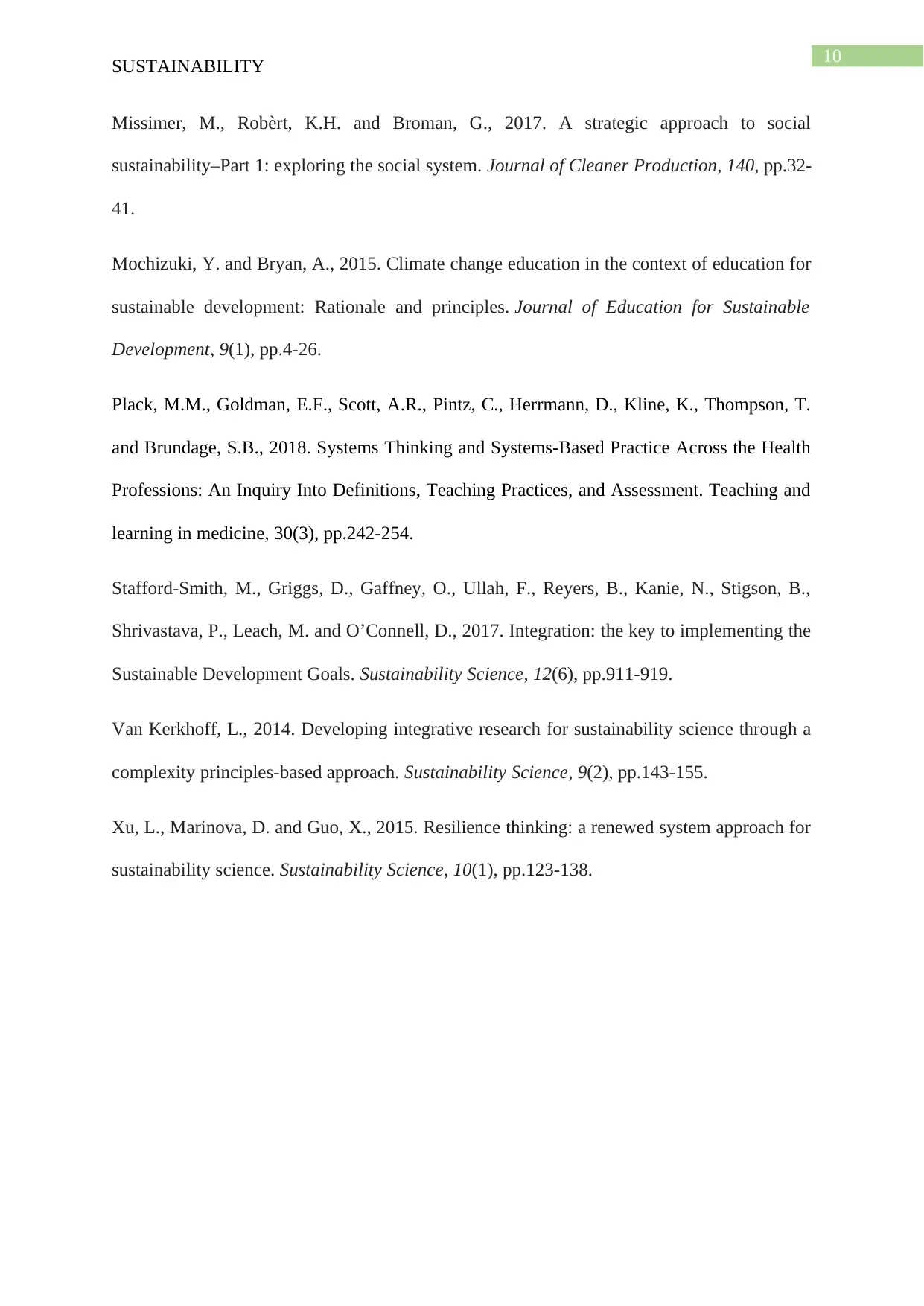
10
SUSTAINABILITY
Missimer, M., Robèrt, K.H. and Broman, G., 2017. A strategic approach to social
sustainability–Part 1: exploring the social system. Journal of Cleaner Production, 140, pp.32-
41.
Mochizuki, Y. and Bryan, A., 2015. Climate change education in the context of education for
sustainable development: Rationale and principles. Journal of Education for Sustainable
Development, 9(1), pp.4-26.
Plack, M.M., Goldman, E.F., Scott, A.R., Pintz, C., Herrmann, D., Kline, K., Thompson, T.
and Brundage, S.B., 2018. Systems Thinking and Systems-Based Practice Across the Health
Professions: An Inquiry Into Definitions, Teaching Practices, and Assessment. Teaching and
learning in medicine, 30(3), pp.242-254.
Stafford-Smith, M., Griggs, D., Gaffney, O., Ullah, F., Reyers, B., Kanie, N., Stigson, B.,
Shrivastava, P., Leach, M. and O’Connell, D., 2017. Integration: the key to implementing the
Sustainable Development Goals. Sustainability Science, 12(6), pp.911-919.
Van Kerkhoff, L., 2014. Developing integrative research for sustainability science through a
complexity principles-based approach. Sustainability Science, 9(2), pp.143-155.
Xu, L., Marinova, D. and Guo, X., 2015. Resilience thinking: a renewed system approach for
sustainability science. Sustainability Science, 10(1), pp.123-138.
SUSTAINABILITY
Missimer, M., Robèrt, K.H. and Broman, G., 2017. A strategic approach to social
sustainability–Part 1: exploring the social system. Journal of Cleaner Production, 140, pp.32-
41.
Mochizuki, Y. and Bryan, A., 2015. Climate change education in the context of education for
sustainable development: Rationale and principles. Journal of Education for Sustainable
Development, 9(1), pp.4-26.
Plack, M.M., Goldman, E.F., Scott, A.R., Pintz, C., Herrmann, D., Kline, K., Thompson, T.
and Brundage, S.B., 2018. Systems Thinking and Systems-Based Practice Across the Health
Professions: An Inquiry Into Definitions, Teaching Practices, and Assessment. Teaching and
learning in medicine, 30(3), pp.242-254.
Stafford-Smith, M., Griggs, D., Gaffney, O., Ullah, F., Reyers, B., Kanie, N., Stigson, B.,
Shrivastava, P., Leach, M. and O’Connell, D., 2017. Integration: the key to implementing the
Sustainable Development Goals. Sustainability Science, 12(6), pp.911-919.
Van Kerkhoff, L., 2014. Developing integrative research for sustainability science through a
complexity principles-based approach. Sustainability Science, 9(2), pp.143-155.
Xu, L., Marinova, D. and Guo, X., 2015. Resilience thinking: a renewed system approach for
sustainability science. Sustainability Science, 10(1), pp.123-138.
1 out of 11
Related Documents
Your All-in-One AI-Powered Toolkit for Academic Success.
+13062052269
info@desklib.com
Available 24*7 on WhatsApp / Email
![[object Object]](/_next/static/media/star-bottom.7253800d.svg)
Unlock your academic potential
© 2024 | Zucol Services PVT LTD | All rights reserved.





